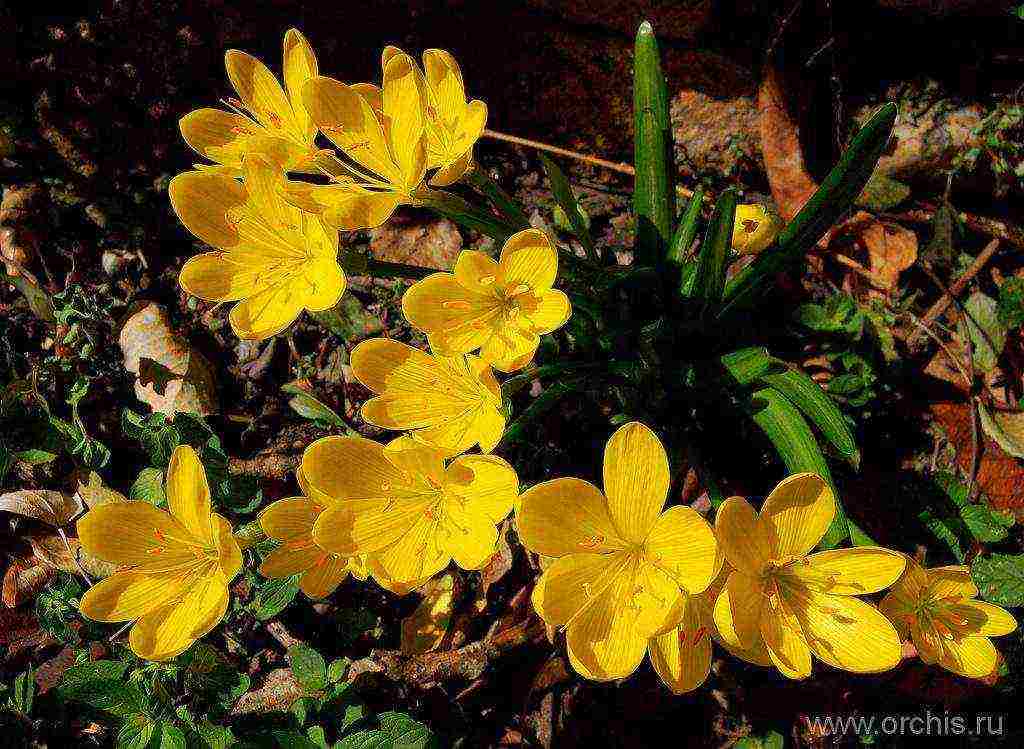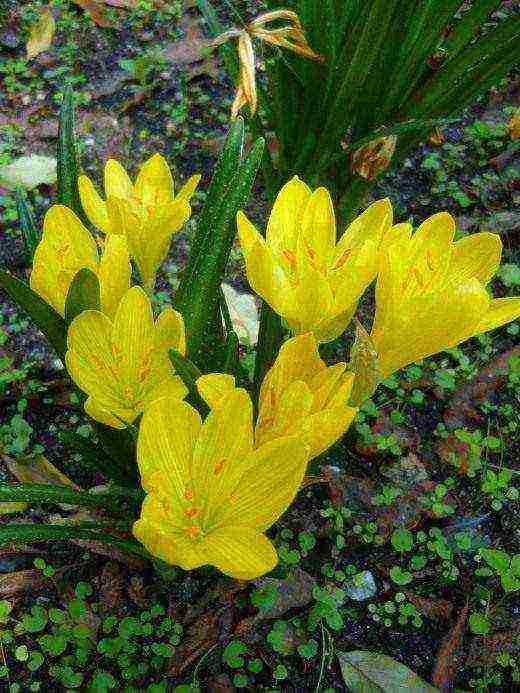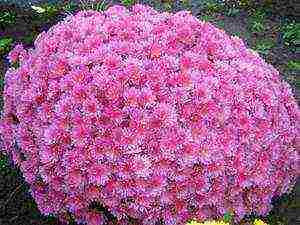Content
Sternbergia (Sternbergia) genus of the Amaryllis family (Amaryllidbceae)
Description of the Sternbergia plant
Perennial low, bulbous plants. They have linear, belt-like, dense basal leaves. Flowers are single funnel-shaped. The color is usually yellow with a golden tint, but there is also a white-flowered appearance. Sternbergia is an ephemeroid plant. There are 8 species in the genus.

Landing Sternbergia
Basically, only two species that are particularly cold-resistant are planted in the middle lane. Light, loose soil with neutral acidity is suitable for sternbergia. Excess moisture in the soil is very harmful to the plant, therefore, good drainage must be ensured.
Bulbs are planted in groups, maintaining a distance of 20 cm between them. In our climate, the best time for planting is summer. You can add compost with sand to the planting hole. When the plant is planted, the land needs to be watered and mulched with gravel. This will help contain the growth of weeds. You should be careful, as the sternbergia bulbs are poisonous.
Sternberg care
Sternbergia will be comfortable in the sun. But it grows quietly in a small partial shade. It is imperative to protect it from cold winds. After flowering, the leaves grow vigorously, but at the end of April they die off and the sternbergia has a dormant time until the end of summer. In the spring, near the overwintered sternbergia, the soil is mulched. The rest of the care measures are loosening and weeding.

Watering
The plant tolerates drought relatively calmly, so you need to water the sternberg in moderation, but regularly. During particularly hot periods, watering can be increased. But in the spring, when the leaves of the sternbergia die off, it must be stopped.
Winter hardiness
For the winter, it is better to insulate the sternberg with leaves and brushwood or mulch. Can be transplanted into a pot and kept at home.
Pruning
You can trim the leaves of shernbergia only when they are brown. Withered flowers are also removed.
Bloom
Blooms depending on the species. There are early flowering sternbergia with an autumn flowering period.
Top dressing
In the spring, it is good to add horn shavings to the soil. Mineral formulations can also be used.
Transfer
Sternbergia grows quietly without transplants for up to five years. Nevertheless, it is necessary to periodically divide the nests of the bulbs. But very carefully, since sternbergia does not like transplanting and destruction of an earthen coma near the roots.
Growing indoors
Sternbergia is also quite suitable for keeping a house or in a greenhouse. Here it usually blooms especially magnificently. You can take the usual garden soil with the addition of humus or sand. It is better to transplant it at home after flowering every 3 years.

Reproduction of Sternbergia
Daughter bulbs
Babies appear on the sternbergia bulbs in large numbers. It is better to dig them out in the summer, and immediately separate the baby, planting it in a permanent place.
Diseases and pests of Sternbergia
Sternbergia leaves can suffer from snails and slugs, and bulbs from insects in the soil. Insecticides will help here, it is better to scatter them over the surface of the soil, and then water the plant. This will allow them to penetrate to the level of the bulbs.
Varieties and types of Sternbergia
- Sternbergia yellow (St. Lutea). Height about 15 cm. Late flowering plant. The flowers are smaller than other species, lemon yellow in color and have a faint aroma. Flowering time from October to mid-November. One of the sternbergia varieties (Angustifolid) is particularly frost-resistant;
- Sternbergia large-flowered (St. Grandiflorum). Perennial plant about 40 cm high with larger flowers, pale yellow color. Blooms from mid-September for about a month;
- Sternberg Fischer (St. Fischeriana). Probably the earliest flowering species, but at the same time frost-resistant. Mainly growing in a greenhouse or indoor conditions, it can bloom in February. Very sensitive to weather and conditions of detention;
- Sternbergia snow-white (St. candida). It blooms in early spring. It is the only white-flowered and rare species.
Video with Sternbergia
Name: in honor of Count von Sternberg (1761-1838), a botanist and writer from Prague.
Description: the genus includes 5 species growing on the dry slopes of the lower mountain belt of the Mediterranean, Eastern Europe and Southwest Asia.
Perennial bulbous plants with belt-like basal leaves up to 40 cm long. Flowers are single, rarely two, and one plant develops 10-13 peduncles up to 20 cm long. The flowers are bright yellow, funnel-shaped, with a short tube, up to 3 cm in diameter. They bloom in late autumn or early spring, profusely and for a long time. The fruit is a fleshy capsule. If you want to cultivate sternbergia in the open field, you must choose a site with very well-permeable soil and carefully cover the plants for the winter. They are harmed not so much by the low temperature as by the excess moisture.
Sternbergia yellow - St. lutea (L.) Roem. et Schult. = Amaryllis lutea L
Homeland - Eastern Transcaucasia, Mediterranean. Grows wild on dry slopes.
One of the most late flowering drought-resistant bulbous plants. Blooms profusely in early October - mid November. One plant develops up to 13 lemon-yellow flowers with a weak delicate aroma, each of which lives for 5-6 days. The leaves are dark green, dense, very shiny, appear late, during the period of mass flowering of plants. By mid-January, sternbergia reaches 15 cm in height and in continuous plantings forms a beautiful bright green carpet, which retains its decorative effect until April. Bulbous bulbs are broadly round, 4 cm in height and 3 cm in width, giving a large number of daughter bulbs. Sternbergia seeds in culture do not tie and reproduce only by children who are planted in the ground in September. In the conditions of the Absheron Peninsula, it can grow without irrigation, and caring for it comes down to a shelf of weeds and loosening. In culture since 1565.
Sternbergia large-flowered - St. grandiflorum L.
Perennial herbaceous
bulbous plant
up to 40 cm high. Corm spherical, up to 7 cm in diameter, dark scales. Leaves are linear, dark green, shiny, dense, up to 40 cm long, appear during budding. Peduncle 25 - 30 cm high. Flowers are solitary, funnel-shaped, 4.5 cm in diameter, lemon-yellow, fragrant, up to 6.5 cm in diameter. Blooms in mid-September for up to 25 days.
Sternbergia Fischer - St. fischeriana (Herb.) Roem.
In the wild, it grows in the Akhsu and Astrakhan Bazar regions on grassy slopes. Named after a Russian botanist of the first half of the 19th century. FB Fisher.
This is one of the earliest flowering plants in the Botanical Garden of the Institute of Botany of the Academy of Sciences of Azerbaijan in sunny and warm weather (plus 7-8 °) blooms in early January. On cloudy days, even at 8-10 ° C, the buds do not open. Short-term frosts (minus 3-5 °) completely stop the growth and development of unopened buds, but do not affect their viability. It was observed that with the establishment of warm weather (plus 7-10 °), mass flowering began on January 28-29 and continued until March 4. The duration of flowering depends on the weather conditions. The leaves are green, dull, appear almost simultaneously with the buds. In a warm dry winter, the beginning of their regrowth was noted on January 3-4, mass - on January 7 - 10, the beginning of budding - January 6, mass budding - 10. Flowering began on January 9 and lasted 5-6 weeks, and sometimes more. Each flower lived for 8-10 days.
Fischer's Sternbergia reproduces exclusively by dividing the bulbs. This is a plant with a spherical bulb up to 5 cm in diameter. In culture since 1868.
S. fischeriana (Herb.) Roem. subsp. hissarica (Kapinos) Artjush... - S. Fischer subspecies Hissar.Differs from the main species in a paler colored perianth and often 2 flowers on a peduncle. It grows in the area of the Gissar ridge.
Location: prefer sunny, sheltered from the wind places with nutritious sandy-clay soil. Drainage is essential for successful cultivation.
Non-frost-resistant. In the culture of the southern regions of the country. In pots, they can be grown in rooms and greenhouses, where they bloom profusely and for a long time.
Reproduction: only baby bulbs. Seeds are tied poorly, besides, seedlings bloom for 4-5 years. In one place they can grow up to 6 years. The bulbs are dug up in the summer, the baby is separated and immediately planted in a permanent place.
Usage: most suitable for rocky gardens in the southern regions of Russia. Using these species, you can create an exceptionally beautiful green carpet with bright yellow flowers from the beginning of October to May.The best results are obtained with a plant nutrition area of 25x20 cm.Yellow Sternbergia is good to use in ordinary and group plantings in flower beds and in small groups on the lawn.
Discuss this article on the forum
- Lakfiol: growing a flower
- Scevola pleasing - a flower from australia
- Choosing a place for planting tigridia
- Brugmansia or datura - trumpets of angels
- What cleome needs
Name: in honor of Count von Sternberg (1761-1838), a botanist and writer from Prague.
Description: the genus includes 5 species growing on the dry slopes of the lower mountain belt of the Mediterranean, Eastern Europe and Southwest Asia.
Perennial bulbous plants with belt-like basal leaves up to 40 cm long. Flowers are single, rarely two, and one plant develops 10-13 peduncles up to 20 cm long. The flowers are bright yellow, funnel-shaped, with a short tube, up to 3 cm in diameter. They bloom in late autumn or early spring, profusely and for a long time. The fruit is a fleshy capsule. If you want to cultivate sternbergia in the open field, you must choose a site with very well-permeable soil and carefully cover the plants for the winter. They are harmed not so much by the low temperature as by the excess moisture.
Sternbergia yellow - St. lutea (L.) Roem. et Schult. = Amaryllis lutea L
Homeland - Eastern Transcaucasia, Mediterranean. Grows wild on dry slopes.
One of the most late flowering drought-resistant bulbous plants. Blooms profusely in early October - mid November. One plant develops up to 13 lemon-yellow flowers with a weak delicate aroma, each of which lives for 5-6 days. The leaves are dark green, dense, very shiny, appear late, during the period of mass flowering of plants. By mid-January, sternbergia reaches 15 cm in height and in continuous plantings forms a beautiful bright green carpet, which retains its decorative effect until April. Bulbous bulbs are broadly round, 4 cm in height and 3 cm in width, giving a large number of daughter bulbs. Sternbergia seeds in culture do not tie and reproduce only by children who are planted in the ground in September. In the conditions of the Absheron Peninsula, it can grow without irrigation, and caring for it comes down to a shelf of weeds and loosening. In culture since 1565.
Sternbergia large-flowered - St. grandiflorum L.
Perennial herbaceous
bulbous plant
up to 40 cm high. Corm spherical, up to 7 cm in diameter, dark scales. Leaves are linear, dark green, shiny, dense, up to 40 cm long, appear during budding. Peduncle 25 - 30 cm high. Flowers are solitary, funnel-shaped, 4.5 cm in diameter, lemon-yellow, fragrant, up to 6.5 cm in diameter. Blooms in mid-September for up to 25 days.
Sternbergia Fischer - St. fischeriana (Herb.) Roem.
In the wild, it grows in the Akhsu and Astrakhan Bazar regions on grassy slopes. Named after a Russian botanist of the first half of the 19th century. FB Fisher.
This is one of the earliest flowering plants in the Botanical Garden of the Institute of Botany of the Academy of Sciences of Azerbaijan in sunny and warm weather (plus 7-8 °) blooms in early January.On cloudy days, even at 8-10 ° C, the buds do not open. Short-term frosts (minus 3-5 °) completely stop the growth and development of unopened buds, but do not affect their viability. It was observed that with the establishment of warm weather (plus 7-10 °), mass flowering began on January 28-29 and continued until March 4. The duration of flowering depends on the weather conditions. The leaves are green, dull, appear almost simultaneously with the buds. In a warm dry winter, the beginning of their regrowth was noted on January 3-4, mass - on January 7 - 10, the beginning of budding - January 6, mass budding - 10. Flowering began on January 9 and lasted 5-6 weeks, and sometimes more. Each flower lived for 8-10 days.
Fischer's Sternbergia reproduces exclusively by dividing the bulbs. This is a plant with a spherical bulb up to 5 cm in diameter. In culture since 1868.
S. fischeriana (Herb.) Roem. subsp. hissarica (Kapinos) Artjush... - S. Fischer subspecies Hissar. Differs from the main species in a paler colored perianth and often 2 flowers on a peduncle. It grows in the area of the Gissar ridge.
Location: prefer sunny, sheltered from the wind places with nutritious sandy-clay soil. Drainage is essential for successful cultivation.
Non-frost-resistant. In the culture of the southern regions of the country. In pots, they can be grown in rooms and greenhouses, where they bloom profusely and for a long time.
Reproduction: only baby bulbs. Seeds are tied poorly, besides, seedlings bloom for 4-5 years. In one place they can grow up to 6 years. The bulbs are dug up in the summer, the baby is separated and immediately planted in a permanent place.
Usage: most suitable for rocky gardens in the southern regions of Russia. Using these species, you can create an exceptionally beautiful green carpet with bright yellow flowers from the beginning of October to May.The best results are obtained with a plant nutrition area of 25x20 cm.Yellow Sternbergia is good to use in ordinary and group plantings in flower beds and in small groups on the lawn.
With the arrival of autumn, a lull sets in in the garden: the last flowers fade, the cover of lawn grasses fades, trees lose their foliage. But it is at this time that the sternbergia begins to bloom! This amazing baby seems to fill the flower beds with sunlight, returning the warmth of the past summer to our garden. Let's take a closer look at this plant.
 Sternbergia
Sternbergia
Sternbergia (Latin Sternbergia) belongs to the amaryllis family. In nature, there are 5-8 species common in the Mediterranean, the mountains of the Crimea and the Caucasus. All of them are undersized perennial bulbous plants that look like crocuses. Sternbergia bulbs are pear-shaped, dark in color. Leaves are linear, dark green, shiny. Flowers are solitary, funnel-shaped, rich golden yellow color. Sternbergia blooms very profusely throughout September - October, but there are species that bloom in spring. Leaves enhance growth after flowering, and in the south they do not stop growing even in winter. By the end of April, the leaves die off and the plants go into a dormant period until the end of summer.
The southerner sternbergia prefers sunny, sheltered areas. For the winter, it must be covered with a layer of mulch. It is necessary to plant this plant in fertile, well-drained soil to a depth of 10 cm at a distance of 15-20 cm. Otherwise, it is undemanding to keeping conditions, resistant to diseases, and not affected by pests.
 Sternbergia
Sternbergia
In a garden, sternbergia does not bear fruit, but reproduces very well with daughter bulbs. You need to divide old nests every 3-5 years, but even with annual division, the plants grow rapidly. Daughter bulbs ripen quickly and begin to bloom after 1-2 years. Due to the high reproduction rate of sternbergia without special care, in a short period of time it forms a continuous cover on the lawn or under the canopy of trees.
In culture, yellow sternbergia (Sternbergia lutea) is most often grown.Also known are the large-flowered sternbergia (Sternbergia macrantha) and Fischer's sternbergia (Sternbergia fischeriana), which bloom in early spring.
 Sternbergia
Sternbergia
In horticulture, sternbergia is used as a ground cover plant under the canopy of trees and shrubs. Due to its small size, it is well suited for planting in rock gardens and rockeries. Like all bulbous sternbergia, it is suitable for forcing and cutting.
Of course, this plant, still rarely found in our gardens, deserves a wider distribution.


